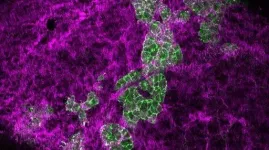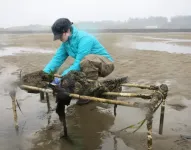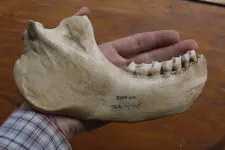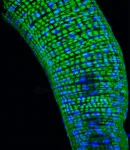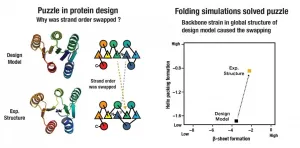(Press-News.org) Tooth loss is often accepted as a natural part of aging, but what if there was a way to better identify those most susceptible without the need for a dental exam?
New research led by investigators at Harvard School of Dental Medicine suggests that machine learning tools can help identify those at greatest risk for tooth loss and refer them for further dental assessment in an effort to ensure early interventions to avert or delay the condition.
The study, published June 18 in PLOS ONE, compared five algorithms using a different combination of variables to screen for risk. The results showed those that factored medical characteristics and socioeconomic variables, such as race, education, arthritis, and diabetes, outperformed algorithms that relied on dental clinical indicators alone.
"Our analysis showed that while all machine-learning models can be useful predictors of risk, those that incorporate socioeconomic variables can be especially powerful screening tools to identify those at heightened risk for tooth loss," said study lead investigator Hawazin Elani, assistant professor of oral health policy and epidemiology at HSDM.
The approach could be used to screen people globally and in a variety of health care settings even by non-dental professionals, she added.
Tooth loss can be physically and psychologically debilitating. It can affect quality of life, well-being, nutrition, and social interactions. The process can be delayed, even prevented, if the earliest signs of dental disease are identified, and the condition treated promptly. Yet, many people with dental disease may not see a dentist until the process has advanced far beyond the point of saving a tooth. This is precisely where screening tools could help identify those at highest risk and refer them for further assessment, the team said.
In the study, the researchers used data comprising nearly 12,000 adults from the National Health and Nutrition Examination Survey to design and test five machine-learning algorithms and assess how well they predicted both complete and incremental tooth loss among adults based on socioeconomic, health, and medical characteristics.
Notably, the algorithms were designed to assess risk without a dental exam. Anyone deemed at high risk for tooth loss, however, would still have to undergo an actual exam, the researchers added.
The results of the analysis point to the importance of socioeconomic factors that shape risk beyond traditional clinical indicators.
"Our findings suggest that the machine-learning algorithm models incorporating socioeconomic characteristics were better at predicting tooth loss than those relying on routine clinical dental indicators alone," Elani said. "This work highlights the importance of social determinants of health. Knowing the patient's education level, employment status, and income is just as relevant for predicting tooth loss as assessing their clinical dental status."
Indeed, it has long been known that low-income and marginalized populations experience a disproportionate share of the burden of tooth loss, likely due to lack of regular access to dental care, among other reasons, the team said.
"As oral health professionals, we know how critical early identification and prompt care are in preventing tooth loss, and these new findings point to an important new tool in achieving that," said Jane Barrow, associate dean for global and community health and executive director of the Initiative to Integrate Oral Health and Medicine at HSDM. "Dr. Elani and her research team shed new light on how we can most effectively target our prevention efforts and improve quality of life for our patients."
The research was done in collaboration with researchers at the Harvard T.H. Chan School of Public Health, the University of São Paolo in Brazil, and the University of Otago Faculty of Dentistry in New Zealand.
Co-investigators included André F. M. Batista, W. Murray Thomson, Ichiro Kawachi, and Alexandre D. P. Chiavegatto Filho.
This work was supported by the National Institute on Minority Health And Health Disparities (grant K99MD012253) and CNPq (grant 308731/2018-2).
INFORMATION:
A new resource developed at the Garvan Institute of Medical Research and The Kinghorn Cancer Centre for oncologists could help make targeted cancer therapies more accessible for Australian patients.
The TOPOGRAPH (Therapy-Oriented Precision Oncology Guidelines for Recommending Anti-cancer Pharmaceuticals) database is an online tool that catalogues oncology research to streamline the process of recommending therapeutic treatments in precision cancer medicine.
Garvan Senior Research Officer Dr Frank Lin led the development of the platform reported this week in the journal npj Precision Oncology.
"TOPOGRAPH is uniquely useful in the Australian context because it combines ...
Wastewater treatment facilities clean the water that goes down our sinks and flushes our toilets, but they do not remove everything. A recent study by Portland State researchers detected low levels of pharmaceuticals and personal care product chemicals in oysters the team deployed at various distances from wastewater effluent pipes along the Oregon and Washington coast. Elise Granek, professor of environmental science and management at Portland State University, and Amy Ehrhart, a recent graduate of PSU's Earth, Environment, and Society doctoral program, conducted the study.
To explore how aquatic pollution varies based on proximity to wastewater facilities, Ehrhart and Granek placed one-week-old ...
Researchers at Harvard University and the Broad Institute of MIT and Harvard have created a first detailed atlas of a critical region of the developing mouse brain, applying multiple advanced genomic technologies to the part of the cerebral cortex that is responsible for processing sensation from the body. By measuring how gene activity and regulation change over time, researchers now have a better understanding of how the cerebral cortex is built, as well as a brand new set of tools to explore how the cortex is affected in neurodevelopmental disease. The study is published in the journal Nature.
"We have had a long-standing interest in understanding the development of the mammalian cerebral cortex, as it is ...
UNIVERSITY PARK, Pa. -- Using an unusually well-preserved subfossil jawbone, a team of researchers -- led by Penn State and with a multi-national team of collaborators including scientists from the Université d'Antananarivo in Madagascar -- has sequenced for the first time the nuclear genome of the koala lemur (Megaladapis edwardsi), one of the largest of the 17 or so giant lemur species that went extinct on the island of Madagascar between about 500 and 2,000 years ago. The findings reveal new information about this animal's position on the primate family tree and how it interacted with its environment, which could help in understanding the impacts of past lemur extinctions on Madagascar's ecosystems.
"More than 100 species of lemurs live on Madagascar today, ...
To better understand the role of bacteria in health and disease, National Institutes of Health researchers fed fruit flies antibiotics and monitored the lifetime activity of hundreds of genes that scientists have traditionally thought control aging. To their surprise, the antibiotics not only extended the lives of the flies but also dramatically changed the activity of many of these genes. Their results suggested that only about 30% of the genes traditionally associated with aging set an animal's internal clock while the rest reflect the body's response to bacteria.
"For ...
COLUMBUS, Ohio - When the summer sun blazes on a hot city street, our first reaction is to flee to a shady spot protected by a building or tree.
A new study is the first to calculate exactly how much these shaded areas help lower the temperature and reduce the "urban heat island" effect.
Researchers created an intricate 3D digital model of a section of Columbus and determined what effect the shade of the buildings and trees in the area had on land surface temperatures over the course of one hour on one summer day.
"We can use the information from our model to formulate guidelines for community greening and tree planting efforts, and even where to locate buildings to maximize shading on other buildings and roadways," said Jean-Michel Guldmann, co-author of the study and ...
A new tool to help conserve one of the UK's most threatened mammals has been released today, with the publication of the first high-quality reference genome for the European water vole. The genome was generated by scientists at the Wellcome Sanger Institute, in collaboration with animal conservation charity the Wildwood Trust, as part of the Darwin Tree of Life Project.
The genome, published today (24 June 2021) through Wellcome Open Research, is openly available as a reference for researchers seeking to assess water vole population genetics, better understand how the species has evolved and to manage reintroduction efforts.
The European water vole (Arvicola ...
A team from Japan and the United States has identified the design principles for creating large "ideal" proteins from scratch, paving the way for the design of proteins with new biochemical functions.
Their results appear June 24, 2021, in Nature Communications.
The team had previously developed principles to design small versions of what they call "ideal proteins," which are structures without internal energetic frustration.
Such proteins are typically designed with a molecular feature called beta strands, which serve a key structural role for the molecules. In ...
Our planet's strongest ocean current, which circulates around Antarctica, plays a major role in determining the transport of heat, salt and nutrients in the ocean. An international research team led by the Alfred Wegener Institute has now evaluated sediment samples from the Drake Passage. Their findings: during the last interglacial period, the water flowed more rapidly than it does today. This could be a blueprint for the future and have global consequences. For example, the Southern Ocean's capacity to absorb CO2 could decrease, which would in turn intensify climate change. The study has now been published in the journal Nature Communications.
The Antarctic Circumpolar Current (ACC) is the world's strongest ocean ...
Indonesia's volcanoes are among the world's most dangerous. Why? Through chemical analyses of tiny minerals in lava from Bali and Java, researchers from Uppsala University and elsewhere have found new clues. They now understand better how the Earth's mantle is composed in that particular region and how the magma changes before an eruption. The study is published in Nature Communications.
Frances Deegan, the study's first author and a researcher at Uppsala University's Department of Earth Sciences, summarises the findings.
"Magma is formed in the mantle, and the composition of the mantle under Indonesia used to be only partly known. ...
